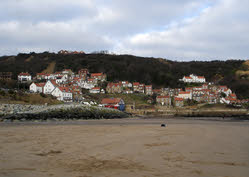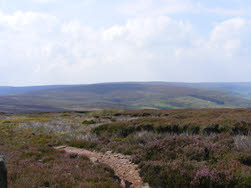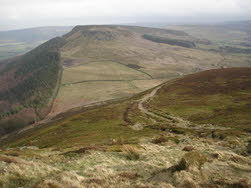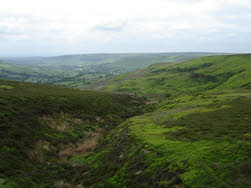

 The North York Moors are one of the lesser known English national parks, sitting a little away from major population centres. Despite this the area is stunning, with wide expanses of heather moorland and beautiful valleys, with a sense of remoteness that is sometimes hard to find in the more popular parks. It is also possible to spend all day striding out at high level across the moors without too much effort, especially on the long ridges that split the main dales.
The North York Moors are one of the lesser known English national parks, sitting a little away from major population centres. Despite this the area is stunning, with wide expanses of heather moorland and beautiful valleys, with a sense of remoteness that is sometimes hard to find in the more popular parks. It is also possible to spend all day striding out at high level across the moors without too much effort, especially on the long ridges that split the main dales.
The North York Moors have a fairly simple structure. In the north the River Esk runs from west to east across the top of the Moors, entering the North Sea at Whitby. The highest parts of the moors tend to be just to the south of Esk Dale. A series of dales runs south from this higher ground - Rye Dale, Bilsdale, Rosedale, Farndale and Bransdale being the best known. To the south are the Tabular Hills, another lower range of hills which slope up gently from the south and end in steep escarpments facing north towards the high moors. The rivers running out of the dales cut their way through the Tabular Hills in narrower valleys.
 It is of course the heather moors that dominate here, and one of the nicest features of the area is that many of the north-south roads follow the ridges, taking you easily up into the heart of the heather. At the right time of year the entire area turns into a sea of purple, stretching out from the highest moors almost to the coast.
It is of course the heather moors that dominate here, and one of the nicest features of the area is that many of the north-south roads follow the ridges, taking you easily up into the heart of the heather. At the right time of year the entire area turns into a sea of purple, stretching out from the highest moors almost to the coast.
That coast is another of the region's gems. At the southern end is Scarborough, with a mix of historic, especially the castle, and the seaside holiday, with a thriving row of seaside shops on the South Bay. The cliffs begin north of Scarborough, running up to the failed holiday down of Ravenscar, built oddly on the top of the cliffs. Next comes the delightful village of Robin Hood's Bay, with its main street running steeply down to the water with a network of small alleys to explore.
 Next is Whitby, where the Esk runs into the sea. Once again we have history, with the ruins of Whitby Abbey, but also classy sea food, and a lovely old town to explore. The coast then turns to the west, and a pair of villages clinging onto the cliffs - Runswick Bay, where the original road had to be replaced with a rather less alarming route, and Staithes, where a slightly disappointing upper village conceals a delightful water front.
Next is Whitby, where the Esk runs into the sea. Once again we have history, with the ruins of Whitby Abbey, but also classy sea food, and a lovely old town to explore. The coast then turns to the west, and a pair of villages clinging onto the cliffs - Runswick Bay, where the original road had to be replaced with a rather less alarming route, and Staithes, where a slightly disappointing upper village conceals a delightful water front.
As with so many parts of Britain, the Moors were once the home of powerful Monastic orders. The most impressive ruins within the park are at Rievaulx on the River Rye, where the abbey sits in a steep sided valley. The ruins of Byland Abbey are on the south-western corner of the National Park - at its height Byland Abbey was even larger than Rievaulx but the ruins and the location don't quite match. On the western side of the Moors is Mount Grace Priory, where monks lived an isolated life in individual cells (quite comfortable houses). The Monastic tradition hasn't died in the area and Ampleforth Abbey, close to Byland, is a Benedictine Monastery that has been on its current site since 1802. The first Abbey church was built in 1857 and the current church in 1961.
 One of the more unusual features of the area are the many crosses to be found on the high moors, probably marking routes across the moors.
One of the more unusual features of the area are the many crosses to be found on the high moors, probably marking routes across the moors.
One of the major tourist attractions of the area is the North Yorkshire Moors railway, which runs through the heart of the moors from Pickering in the south to the mainline at Grosmont in the north (from where Whitby can easily be reached). The most famous station on the railway is at Goathland, used as Aidenfield Station in Heartbeat and Hogsmeade Station in the Harry Potter films. My first visit to Goathland came before either series, when it was a quiet attractive village most famous for the long narrow village green that runs along most of the length of the village and for Mallyan Spout, the tallest waterfall in the Moors.
This isn't the only railway in the Moors. The Esk Dale line is almost as scenic, entering the Moors at Kildale and running down the full length of the valley to Whitby. Abandoned railways are also important in the area. The route of the old Rosedale Railway, an industrial line, is now a fantastic walking route that runs around the northern part of Rosedale and Farndale, passing The Lion Inn on Farndale Moor before reaching the edge of the moors at Greenhow Moor, where the Greenhow Incline drops rather steeply down to the lowlands below. The old Scarborough to Whitby Line also provides a good walking route close to the coast, peaking at Ravenscar.